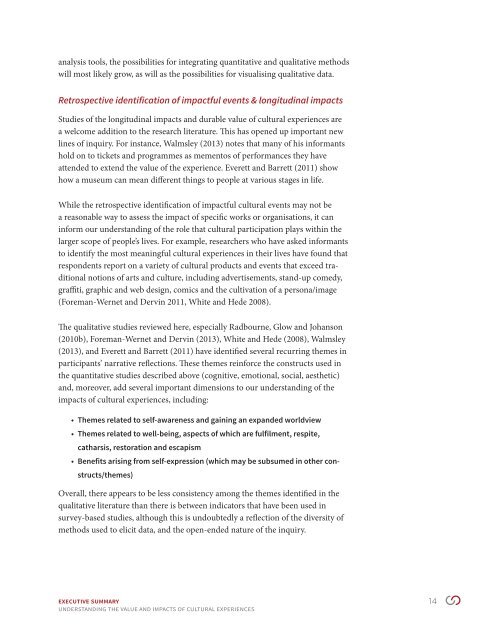aceUVi
aceUVi
aceUVi
You also want an ePaper? Increase the reach of your titles
YUMPU automatically turns print PDFs into web optimized ePapers that Google loves.
analysis tools, the possibilities for integrating quantitative and qualitative methods<br />
will most likely grow, as will as the possibilities for visualising qualitative data.<br />
Retrospective identification of impactful events & longitudinal impacts<br />
Studies of the longitudinal impacts and durable value of cultural experiences are<br />
a welcome addition to the research literature. This has opened up important new<br />
lines of inquiry. For instance, Walmsley (2013) notes that many of his informants<br />
hold on to tickets and programmes as mementos of performances they have<br />
attended to extend the value of the experience. Everett and Barrett (2011) show<br />
how a museum can mean different things to people at various stages in life.<br />
While the retrospective identification of impactful cultural events may not be<br />
a reasonable way to assess the impact of specific works or organisations, it can<br />
inform our understanding of the role that cultural participation plays within the<br />
larger scope of people’s lives. For example, researchers who have asked informants<br />
to identify the most meaningful cultural experiences in their lives have found that<br />
respondents report on a variety of cultural products and events that exceed traditional<br />
notions of arts and culture, including advertisements, stand-up comedy,<br />
graffiti, graphic and web design, comics and the cultivation of a persona/image<br />
(Foreman-Wernet and Dervin 2011, White and Hede 2008).<br />
The qualitative studies reviewed here, especially Radbourne, Glow and Johanson<br />
(2010b), Foreman-Wernet and Dervin (2013), White and Hede (2008), Walmsley<br />
(2013), and Everett and Barrett (2011) have identified several recurring themes in<br />
participants’ narrative reflections. These themes reinforce the constructs used in<br />
the quantitative studies described above (cognitive, emotional, social, aesthetic)<br />
and, moreover, add several important dimensions to our understanding of the<br />
impacts of cultural experiences, including:<br />
• Themes related to self-awareness and gaining an expanded worldview<br />
• Themes related to well-being, aspects of which are fulfilment, respite,<br />
catharsis, restoration and escapism<br />
• Benefits arising from self-expression (which may be subsumed in other constructs/themes)<br />
Overall, there appears to be less consistency among the themes identified in the<br />
qualitative literature than there is between indicators that have been used in<br />
survey-based studies, although this is undoubtedly a reflection of the diversity of<br />
methods used to elicit data, and the open-ended nature of the inquiry.<br />
Executive Summary 14<br />
UNDERSTANDING the value and impacts of cultural experiences


